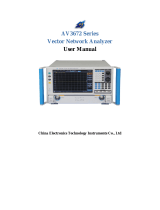
Title
Date:0
Solution: T
Using a Passive Oscilloscope Probe with a Spectrum Analyzer
Date:05/23/2013
Solution: Spectrum Analyzers are typically used to measure radio frequency (RF)
signals. The signals are usually delivered to the RF input of the analyzer with an
antenna, magnetic probe, or using a cable with a matched impedance. This minimizes
impedance mismatching which lowers reflected power and provides the cleanest
measurement. This is not always an acceptable connection scheme. Especially in
circuits that are highly susceptible to loading when attached to low impedance inputs,
like those on most Spectrum Analyzers.
This application note covers using a passive probe, typically used with an
oscilloscope, with a spectrum analyzer. We highlight some of the advantages and
trade-offs with this technique as well.
Most analyzers feature a 50 Ohm input impedance. In fact, many oscilloscopes with
analog bandwidths above a few hundred MHz also feature a 50 Ohm impedance
setting. This lower impedance enables better performance at higher frequencies but
can significantly load a circuit with higher impedance.
In this application note, we will use an RF signal source to deliver a -10dBm signal at
1GHz (CW Sine Wave) to a spectrum analyzer, using a passive 1.5GHz oscilloscope
probe.

Here is a screen capture of the signal directly connected to the input of the spectrum
analyzer using coaxial cable and BNC adapters:
Note that the marker above shows the peak at 1GHz with an amplitude of -10dBm.
Now, we connect a 1.5GHz Passive Probe (Rigol RP6150 Passive probe) to the input
of the spectrum analyzer. The RP6150 is designed to be a 10:1 probe when connected
to 50 ohms.
Using a probe with an impedance greater than 50 ohms acts as a voltage divider for
signals being delivered to the spectrum analyzer. This decreases the voltage to the
input and effectively acts as an attenuator. It also has the advantage of lessening the
circuit loading that can be caused by connecting the 50 ohm spectrum analyzer input
directly to the circuit.

Here is the same signal but instead of a direct connection to the RF input, we are using
an RP6150 probe to detect the signal.
Note that the marker now shows -30dBm for the amplitude. This is due to the probe
attenuation factor.
Let's take a closer look at that probe. Recall that power is the square of the amplitude.
Therefore, you can calculate the probe power ratio by simply squaring the probe
attenuation factor.
Some common probe attenuation ratios can be found using Table 1.
Probe Impedance (Ohms) Probe Attenuation Ratio* Power Ratio dB
50 1:1 1 0
500 10:1 100 20
1M 2000:1 4E+6 66
Table 1: Probe Impedance to dB
*With 50 Ohm Input to Spectrum Analyzer

Now, we can easily calculate the expected measured power using the equation below:
Measured Power (dBm) = Signal Source Power (dBm) – Probe Attenuation ratio (dB)
So, if our Signal Source Power is -10dBm, and the probe attenuation ratio for our
RP6150 Passive Probe is 20dB, we would expect to read -30dB on the spectrum
analyzer as we see in the above screen capture.
For convenience, we can then use the spectrum analyzers internal reference setting to
adjust for the attenuation of the probe.
Simply press AMPT and set the Ref Level to the probe attenuation ratio in dB. This is
a scalar factor that will remove the additional attenuation from the displayed value
and give the corrected power value.

Headquarters
RIGOL TECHNOLOGIES, INC.
No.156,Cai He Village,
Sha He Town,
Chang Ping District, Beijing,
102206 P.R.China
Tel:+86-10-80706688
Fax:+86-10-80705070
Email: [email protected]
USA
RIGOL TECHNOLOGIES,USA INC.
7401 First Place, Suite N
Oakwood Village
OH 44164, USA
Toll free: 877-4-RIGOL-1
Office: (440) 232-4488
Fax: (216)-754-8107
Email: [email protected]
EUROPE
RIGOL TECHNOLOGIES GmbH
Lindbergh str. 4
82178 Puchheim
Germany
Tel: 0049- 89/89418950
Email: [email protected]
-
 1
1
-
 2
2
-
 3
3
-
 4
4
-
 5
5
Ask a question and I''ll find the answer in the document
Finding information in a document is now easier with AI
Related papers
-
Rigol DS4000E Series Quick Manual
-
Rigol PVA8350 3.5GHz Active Differential Probe User guide
-
Rigol RSA5000 User manual
-
Rigol RSA3000 User manual
-
Rigol RP1002C User manual
-
Rigol Cable Loss User manual
-
Rigol DS4024 User manual
-
Rigol DS1052E User manual
-
Rigol DS1074Z-S User manual
-
Rigol RSA3000E Series User manual
Other documents
-
 China Electronics Technology Instruments AV3672 Series User manual
China Electronics Technology Instruments AV3672 Series User manual
-
SIGLENT SDM3065X 6 ½ Digits Dual-Display Digital Multimeter User guide
-
Tektronix TDS1000C-EDU Series User manual
-
HP 8568B User manual
-
 ETS-Lindgren TILE!™ Owner's manual
ETS-Lindgren TILE!™ Owner's manual
-
Agilent Technologies Water Dispenser 856290216 User manual
-
Tektronix TBS1000B Series User manual
-
Tektronix TPS2014B User manual
-
Tektronix TBS1052B User manual
-
Tektronix TPS2000 Series User manual






